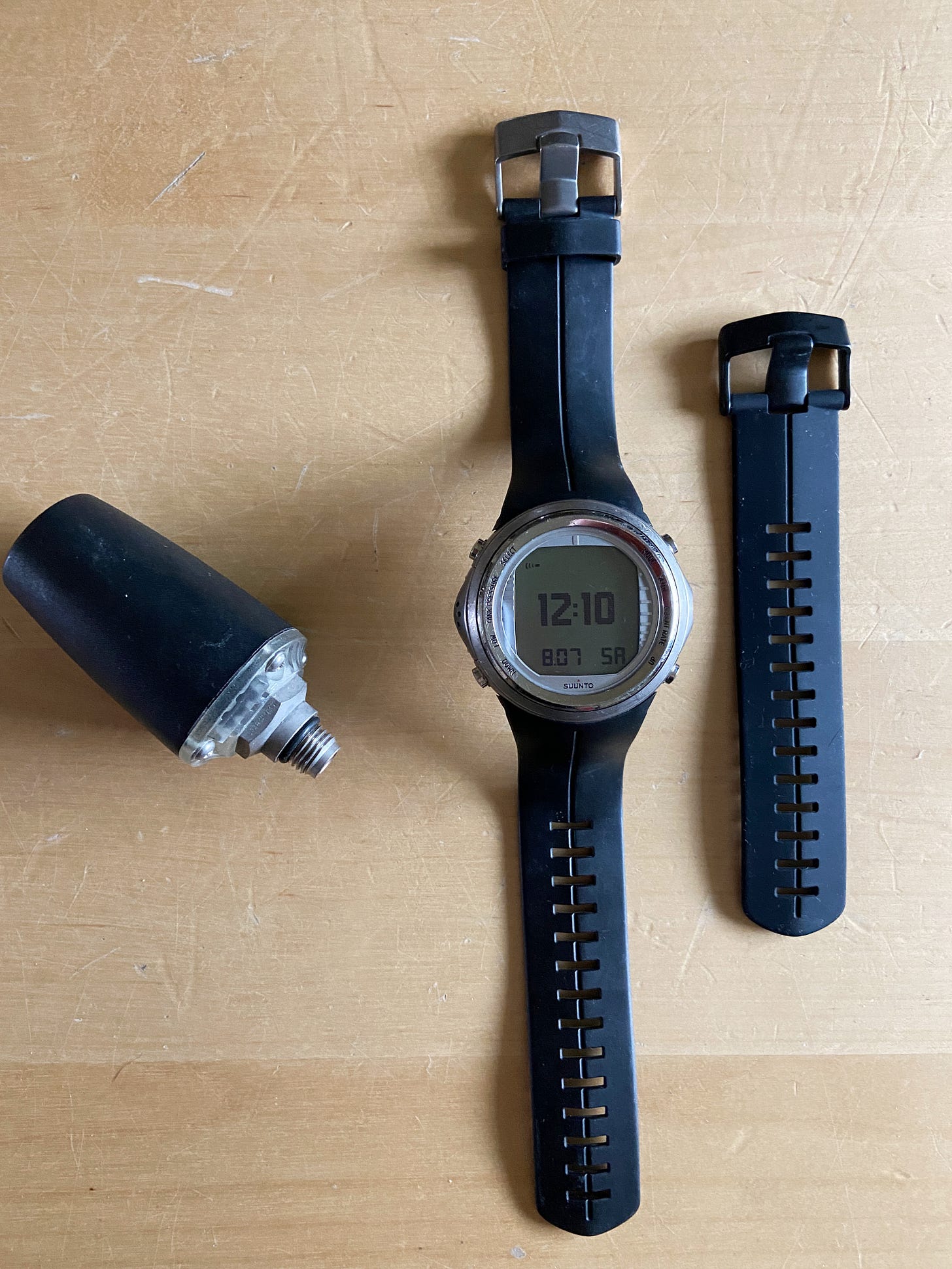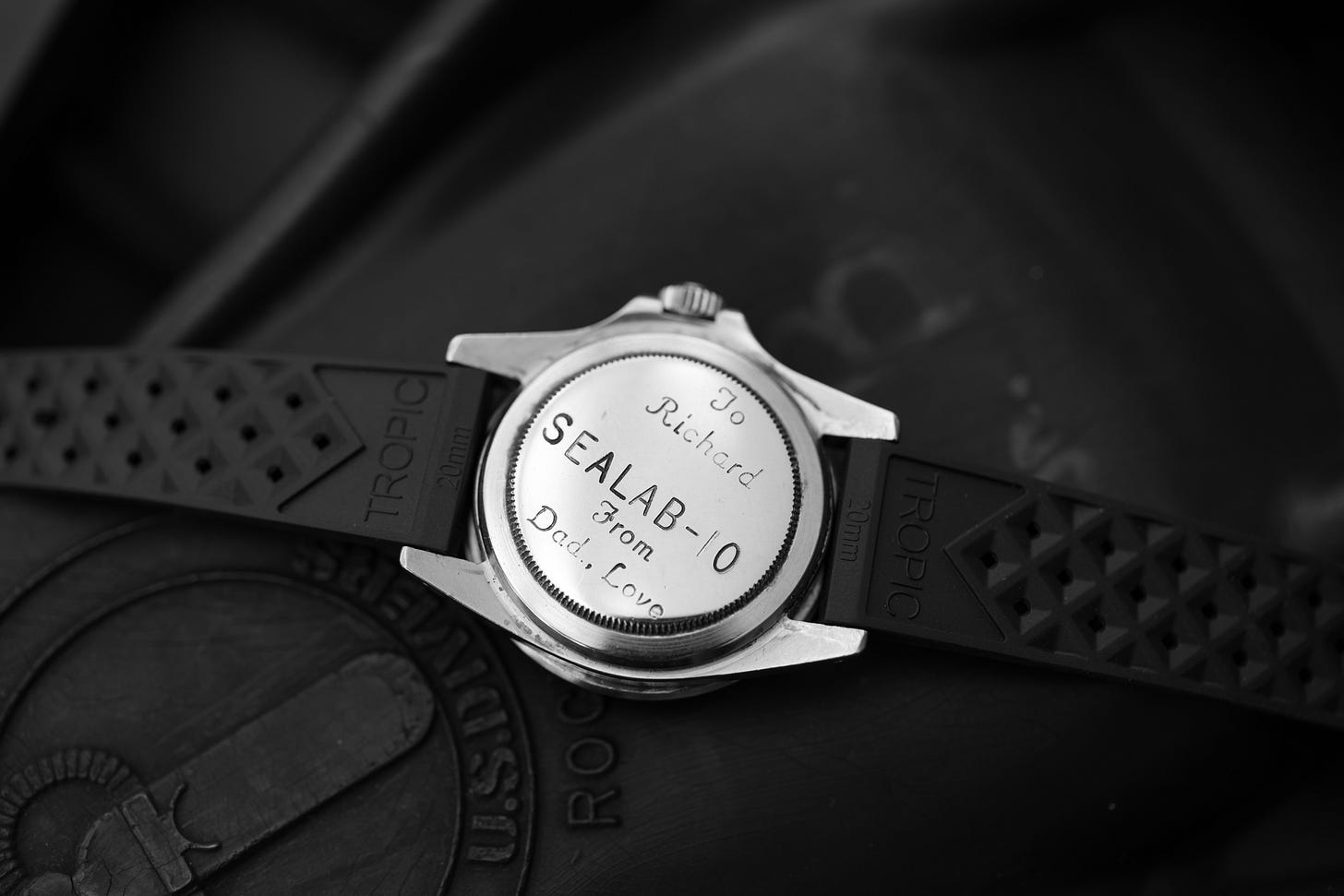A Feeling of Connection
Reflections on tool watches past and present
I recently read an article on a popular watch blog (you know the one), entitled, “Living with the Apple Watch Series 7” and, while I have no quibbles with the theme or content of the review, it made me think about my own relationship with smartwatches. I learned from the article that the Apple Watch has now been around for six years. That’s a long time in the tech world, but a mere blink of an eye in the history of timepieces. But then, the Apple Watch isn’t a timepiece, is it? It’s its own technological ecosystem—the world miniaturized on your wrist. The article postulates that the Apple Watch has become what the iPhone once was, and the iPhone what the laptop used to be. I’ve got this creeping sense that I’m starting to slip behind the curve. And you know what? I’m OK with that.
Those who own a smartwatch and, let’s face it, by “smartwatch” I really mean “Apple Watch”since that’s all you really see on people’s wrists, call it everything from “useful” to “a game changer” to “indispensable.” Now, I can understand how handy it would be to call your spouse from the grocery store without having to pull out your phone, or read an email discreetly during a boring meeting, but I’ve managed to exist, fairly successfully, for the six years of the Apple Watch’s reign, without one. Don’t worry, this isn’t going to be some neo-Luddite screed against the evils of technology. I’ve actually gone on record many times saying that the most useful piece of kit I own is my iPhone, followed closely by my eight-year old MacBook Air. In a few years’ time, will I say the same about a smartwatch? Never say never, but I tend to doubt it. It’s too small to write on or take photos so is destined to always be a supporting character, at best, and likely not on my wrist.
All this having been said, I’m not such a retro-grouch to eschew change or embrace some level of connected tech. I love my Garmin watches. But it’s been a slow build and a learning process to reach the point of adoration for these bright, rechargeable, soulless bits of circuitry. I remember when connected sports watches first came on the scene. I swore I’d never use one. I’d used chest strap heart rate monitors from Suunto and Polar (why were the Scandinavians so obsessed with heart rate?) for biking, running, and skiing, but got bored with them and figured I’d just get to know my exercise thresholds the more I exercise (once I can’t carry on a conversation, I’m in the anaerobic zone; when I start to black out, I’m at max heart rate). And so on. Do I really need to know my daily steps or stairs climbed? My attitude started to change once I committed to wearing a Garmin Fenix for a while.
Data can become addictive, especially when it’s related to your own physiology. Sure, a midrange bike computer strapped to the handlebars can tell my speed, distance, and elevation gained on a given ride, but then the Garmin correlates that info, plus average and max heart rates, a map of my route, temperature, hydration loss, blood oxygen levels, estimated calories burned and historical comparisons, all synced to an app on my phone. Pretty soon I’ve become my own lab rat. And then, I can use the same device to track my distance and stroke count rowing or kayaking, and, in the winter, when I click into my cross-country skis for a few lunchtime kilometers, or track my downhill ski runs. When Garmin developed the Descent dive computer that could do all of the above plus dive tracking, well, it seemed like the ultimate gadget for the modern athlete. I’ve always enjoyed being a multi-sport person and to use the same rugged watch for everything was a dream fulfilled. This was a watch I’d conceivably never have to take off, except to charge it now and then. Had I found the mythical “One Watch”? Short answer: no.
Consider some of the sport-specific tool watches of yesteryear: the Favre-Leuba Bivouac with its barometric altimeter, or the Aquadive Time-Depth 50 with its Bourdon tube depth gauge, or the Memosail regatta timer with its starting gun countdown. I often wonder if the people who bought them for their specific functions took them off after activities, let them run down until the next expedition, dive trip, or weekend sailing race. Would they put on a nice Bulova dress watch with a leather strap for the week? Or would they proudly wear that gargantuan instrument to the office on Monday, a calling card of their chosen passion, a reminder of what inspires them, a motivation to look forward to the next weekend and the adventures that awaited? Therein lies the conflict for me. I’ve long held the belief that a watch is, first and foremost, a collector of memories and an inspiration for future adventures. But nowadays, when I head out the door to bike/run/ski/paddle/hike, I almost always have a GPS-synced, pulse-taking titanium gadget strapped to my wrist. My anti-shock Bremont chronometer or 300-meter rated Rolex dive watch sits on my dresser to slip on after I’m home and dry. It’s the Garmin that collects the memories now, all sliced and diced and logged on an app on my iPhone.
I recently decided to sell my old Suunto D9 dive computer. I snapped some closeup photos of its condition for a post and realized how entirely scratched the titanium case had become. That watch accompanied me on every dive for six or seven years—under the ice, on deep shipwrecks in several oceans, chasing sharks off of remote liveaboards. Now I’m no celebrity and have no illusion that my provenance holds greater value than anyone else’s, but if a Swiss made dive watch from a reputable brand was posted for sale from the original owner, in “unpolished” condition, and a full history of diving all over the world, collectors would clamor. I didn’t get a single nibble of interest.
For the majority of you reading, I don’t need to expound on the allure of traditional, usually mechanical, wristwatches—the history, the craftsmanship, the details, the magic of timekeeping by means of hand assembled gears and springs. For me, while I can appreciate high horology watches like a Patek Philippe or Vacheron, it’s always been the sports watches that fascinated, the more purpose-built, the better. Before the age of digital watches, electronic depth gauges, altimeters and GPS, watchmakers adapted what were formerly fragile mechanisms to survive and serve in the absolute harshest conditions, battlefields, mountain peaks and deep oceans. To take a watch diving is still a revelation every time I do it and it’s really the only sport I do during which I will wear a traditional watch on one wrist and a digital, connected dive computer on the other. And not for any thinly concocted “backup bottom timer” excuse. I simply like to glance down and see this intricately built, archaic gadget quietly doing its job under three or four times atmospheric pressure. I just don’t get the same sense of wonder from my Garmin.
Most of my dive watches have seen bottom time at least once, some many times and I can conjure some fantastic memories just looking at them now: fighting nitrogen narcosis 170 feet deep in Sri Lanka wearing my CWC, kicking like mad to keep up with a giant whale shark in the Maldives wearing my Doxa Searambler, or descending through a halocline in chilly Milford Sound, New Zealand wearing my Rolex Sub. Some of those dives are logged in great detail in an app on my iPhone—my heart rate, my depth profile, GPS coordinates of my entry and exit points—courtesy of my Garmin. But I don’t look at those logs much. Nor do I really feel an attachment to the watch that captured that data. In fact, since my last dive trip—Bonaire in August—my Garmin Descent has remained turned off and tucked inside my dive bag.
I’ve had the pleasure of interviewing several great explorers over the years, many times with a goal of learning about the watches they wore on adventures. Will Steger wore a Rolex GMT-Master on the first dogsled crossing to the North Pole in 1986, yet when I asked him where it was now, he didn’t remember (“You’d have to ask Jim, I think I gave my watches to him.”). Robert Barth, the great Navy diver who participated in all three SEALAB expeditions, was amused by my interest in his old Rolex. To him, it was merely a tool, like his breathing apparatus or fins. Robin Knox-Johnston, the first man to sail solo, nonstop, around the globe, wore a Rolex Explorer for his heroic feat. When I asked him about the watch, I hoped for some nostalgic waxing. Instead, he preferred to tell me how GPS has opened up long distance sailing to more participants. It’s funny how we view mechanical tool watches through a lens of romanticism and nostalgia, but the people who wore them for their intended purposes “back in the day” view them as the functional instruments they were, nothing more, nothing less. “We preferred the Rolexes because they didn’t leak,” Barth told me.
In a few decades, when I’m rocking on my front porch, will some young watch journalist ask me to recall the Suunto I wore diving the Hermes wreck in 2017, what became of my Garmin Descent, or if I ever owned an Apple Watch Series 7? Does anyone ever engrave the back of their digital dive computer? Will the tool watches worn by adventurers today one day become objects of fascination and fetish? Or will our interest in the way watches were used as tools remain rooted in the analog age? Time, as they say, will tell. That is, if my Garmin, or an Apple Watch Series 7, will even boot up by then.





I think the single biggest advantage that traditional watches have over the modern tech is that they're already obsolete. There are no updates, no new releases every year. While a new model may come out every now and then it is unlikely to do anything very different from the one you already have. Add to that the in-built obsolescence of wearable tech and you end up comparing something built to last with no competition and something that is, essentially disposable.
No one is going to be passing on a smart watch to a son or daughter, they will be forgotten or discarded but a good mechanical timepiece will last forever and will always be worth something!